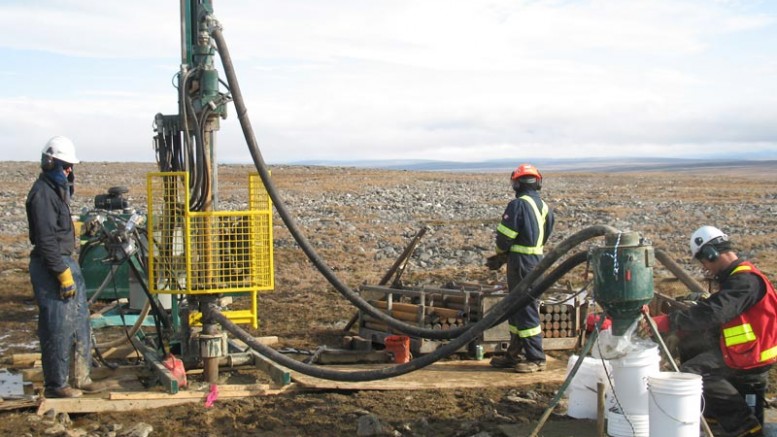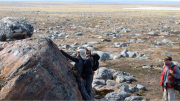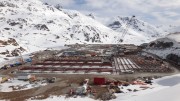Like many junior exploration companies, Peregrine Diamonds (TSX: PGD) has had its share of hard knocks, and its shareholders have had to exercise patience over many years.
The company found diamonds at its Chidliak project on Baffin Island in 2008, and in time attracted heavy-hitting investors like BHP Billiton (NYSE: BHP) and De Beers.
But the financial crisis and commodity downturn got in the way. By November 2011, BHP was questioning whether it wanted to stay invested in the diamond business at all, which included its 51% stake in Chidliak and an 88.9% stake in the Ekati diamond mine in the Northwest Territories.
Peregrine bought BHP’s stake for $9 million and a 2% gross overriding royalty on future mineral production from the project. (BHP sold its stake in Ekati to Harry Winston Diamond, now Dominion Diamond [TSX: DDC; NYSE: DDC], in November 2012.)

Workers load samples from the CH7 kimberlite at Peregrine Diamonds’ Chidliak diamond project. Credit: Peregrine Diamonds
Then it was De Beers’ turn take an interest and then pull out. In October 2013, after signing an option agreement, De Beers elected not to enter into an earn-in and joint venture on the project, 120 km from Iqaluit, Nunavut’s capital.
“When BHP pulled out, it was all about exiting the diamond business,” Thomas Peregoodoff, Peregrine’s president and CEO, says in a telephone interview.
As for De Beers, “it was less a comment about the merit of the project than the state of the mining industry in general and capital allocation. In discussions I had with the technical team … they were disappointed by the decision to exit the project, and … many of them continue to see this as a lost opportunity.”
While this would throw many off their game, Peregrine took the setbacks in stride.

A large diameter drill rig on the CH7 kimberlite at Peregrine Diamonds’ Chidliak diamond project on Baffin Island. Credit: Peregrine Diamonds
Shareholders — including Peregrine chairman Eric Friedland and his brother Robert Friedland — are big believers in the project. They also have deep pockets, and between them own 46% of the company’s stock.
“When you look back over the last two or three years, there have been a number of companies that have had good projects with robust resources, but they didn’t have strong shareholders … and they’ve been forced to make deals that in another environment they wouldn’t have,” Peregoodoff says.
This year the Friedlands and the junior’s other shareholders — big and small — hope that a long-awaited preliminary economic assessment will reward them. The PEA is on track for release in late June. Peregoodoff will only say that management is “quietly optimistic.”
The year is already off to a good start for the company.
In January, Peregrine announced that it had extinguished the 2% gross overriding royalty on future production from Chidliak in an out-of-court settlement with BHP, which tried to transfer the royalty to South32 (LSE: S32; US-OTC: SOUHY), a company that it spun off last year with a number of its less coveted assets, such as manganese, aluminum, silver, nickel and metallurgical coal.
“A lot of people don’t understand the significance,” Peregoodoff says. “If the Chidliak project were to go into production and produce a million carats a year at US$200 a carat, that 2% royalty over a 10-year mine life could be worth US$40 million to US$50 million.”
Peregrine has also reported a 33% increase in the inferred diamond resource at its CH6 kimberlite to 11.4 million carats. CH6 is Chidliak’s flagship kimberlite, and the resource was estimated for the pipe’s first 260 metres.
On April 7 Peregrine reported that tonnage increased 40% from 3.3 million tonnes to 4.6 million tonnes, and contained carats increased 33% from 8.6 million carats to 11.4 million carats.
The revised resource includes a new zone with an estimated 3.2 million carats in 0.8 million tonnes, for 4.2 carats per tonne. Additional tonnage classified as a target for further exploration of 2.3 million to 3.8 million tonnes has also been identified to 380 metres deep below surface at CH6. The pipe is open at depth, and a deep-drill program is in the works.
An independent diamond valuation of a 1,013-carat parcel of diamonds from CH6 by WWW International Diamond Consultants returned an average US$213-per-carat market price and a modelled price (which predicts the average price per carat in a mine-production scenario) that ranged from a minimum of US$162 per carat to a high of US$236 per carat, and a base-model price of US$188 per carat (based on its February 2014 price book).
“If we just look at CH6 alone, it is looking stronger and stronger, and stronger,” Peregoodoff says, adding that the value of the diamonds at CH6 average US$213 to US$214 a carat, “which compares extremely well with anyone’s valuations announced recently.”
He says that “to put it another way, we have over 11 million carats in rock that’s worth somewhere in the neighbourhood of US$400 to US$600 a tonne … and that compares extremely well with the industry average … if CH6 were in production it would be one of the top four or five in terms of revenue per tonne in the world, based on 2014 valuations on WWW International Diamond Consultants.”
Meanwhile, Peregrine is close to completing a maiden resource estimate for the CH7 kimberlite, 15 km southeast of CH6.
In March, WWW International Diamond Consultants evaluated an aggregate 735.8-carat parcel of diamonds (+1.18 mm square diamond mesh) from five geological units of CH7.
The diamond valuation and consulting firm based its valuation on its book price as of Feb. 1, 2016, and found that CH7 diamonds averaged US$100 per carat, and ranged from US$73 to US$154 per carat across the five geological units.
The modelled average price ranged from US$94 per carat to US$155 per carat, with a base-modelled price of US$114 per carat.
The eight highest-value diamonds ranged from 1.4 carats to 5.3 carats, weighed a total 21.6 carats and had a US$1,619-per-carat average price valuation.
In addition to Chidliak, Peregrine controls 11 diamond-prospecting licences in Botswana that cover 6,613 sq. km. Botswana is the world’s largest diamond producer by value, despite the fact that 70% of the country is covered by the Kalahari Desert, which masks prospective targets. Advances in technology, however, improve the chances of finding diamond-bearing kimberlites.
Peregoodoff is particularly excited about a prospecting licence the company recently acquired that includes the diamond-bearing Sikwane kimberlites. The kimberlites were originally discovered by De Beers in the 1970s.
The company has budgeted $550,000 for a work program this year that will focus on the Sikwane licence. About 500 metres of core drilling is planned to test five previously identified diamond-bearing kimberlite occurrences at Sikwane. The targets are supported by drill logs from previous operators. Key to the program, the company says, is to resolve the emplacement morphology of the kimberlitic material, and determine the potential for hosting economic volumes of diamond-bearing kimberlite.






Be the first to comment on "Peregrine Diamonds on cusp of PEA"